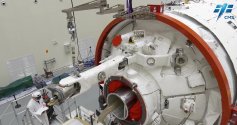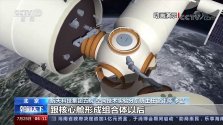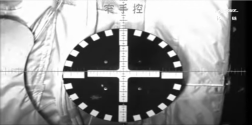Good question. If I understood the video correctly, the main arm has a "capacity" of around 20t, but the smaller arm is about 5t. Which indicates the bigger arm will be used. Also, given the position of the Wentian module, I think the main arm is appropriately situated.Is the smaller arm going to be used for repositioning Wentian or will that be done with something else?
You are using an out of date browser. It may not display this or other websites correctly.
You should upgrade or use an alternative browser.
You should upgrade or use an alternative browser.
China's Space Program News Thread
- Thread starter crazyinsane105
- Start date
- Status
- Not open for further replies.
by78
General
Growing rice in space. One of the experimental cabins on the Wentian module contains a dwarf rice variety named "Xiaowei" (小薇). It was developed by the Chinese Academy of Agricultural Sciences. Due to its 'dwarf' size (reaching a max height of 30cm), the variety is better suited for cultivation in confined spaces of the space station.








Is the smaller arm going to be used for repositioning Wentian or will that be done with something else?
The repositioning will be performed by the Lyappa arm right next to Wentian's docking ring -Good question. If I understood the video correctly, the main arm has a "capacity" of around 20t, but the smaller arm is about 5t. Which indicates the bigger arm will be used. Also, given the position of the Wentian module, I think the main arm is appropriately situated.

Does this arm do anything else on the station other than this job?The repositioning will be performed by the Lyappa arm right next to Wentian's docking ring -
View attachment 94119
It's designed specifically for re-docking purposes.Does this arm do anything else on the station other than this job?
Machine translation:
CCTV news: The Wentian experimental cabin has now completed the rendezvous and docking with the previous docking interface of the core cabin, forming a "one" combination. After completing various preparations, it will be transferred to the lateral docking port of the core cabin. Therefore, a transposition robotic arm is also installed on the Wentian experimental cabin to complete the transfer between the experimental cabin and the core cabin. Bit docking.
The indexing robot arm is the exclusive equipment of the experimental cabin. There is one in Wentian experimental cabin and one in Mengtian experimental cabin. Correspondingly, two bases are respectively set on the node cabins of the Tianhe cabin, which are used for the indexing operation of the two experimental cabins.
Li Zhe, chief designer of the space technology experiment sub-system of the Fifth Academy of Aerospace Science and Technology Group: After forming a combination with the core cabin, the swivel arm will grab the base, and then the two cabins will be separated, and the experimental cabin will be docked from the front of the core cabin. Transfer to the permanent berth, and then combine the two cabins through the docking mechanism, thus completing the entire indexing operation.
The transposition and docking of the Wentian experimental module is the first translocation task in the construction phase of my country's space station. Before that, the robotic arm has verified the feasibility of the technology through the translocation operation between Tianzhou-2 and the core module.
Wei Bangyou, dispatcher of the space station system of the Fifth Academy of Aerospace Science and Technology Group: The task of transposition of this module is also very arduous, especially after the successful transposition of Wentian, the accumulated experience may lay a good foundation for the subsequent transposition of Mengtian.

Is docking straight at the lateral ports physically more difficult in terms of guidance navigation and control? I would have imagined that controlling relative velocity with 6DOF (?) RCS would be very similar no matter which orientation you are going for.
AFAIK the port and starboard 'docking ports' on Tianhe are not equipped for docking, remote or otherwise. Only the front, radial and rear ports are.Is docking straight at the lateral ports physically more difficult in terms of guidance navigation and control? I would have imagined that controlling relative velocity with 6DOF (?) RCS would be very similar no matter which orientation you are going for.
Yes, that is also my understanding. Not equipped for it.AFAIK the port and starboard 'docking ports' on Tianhe are not equipped for docking, remote or otherwise. Only the front, radial and rear ports are.
Yes, that is also my understanding. Not equipped for it.AFAIK the port and starboard 'docking ports' on Tianhe are not equipped for docking, remote or otherwise. Only the front, radial and rear ports are.
From memory, a docking port needs certain receivers/targets (?) to aid capture from an approaching spacecraft. I think the Chinese system is based on the Russian LARS or KURS (might be wrong on the name here). If I understand it correctly, the approaching spacecraft fires a laser at a "receiver/target" on the receiving spacecraft to align its trajectory. These "targets" are only placed on the Forward, Aft, and Radial ports on Tainhe. I'll try and upload a pic.Is docking straight at the lateral ports physically more difficult in terms of guidance navigation and control? I would have imagined that controlling relative velocity with 6DOF (?) RCS would be very similar no matter which orientation you are going for.
- Status
- Not open for further replies.

